AUGUST 2020 ENEWS
Dear friends of Salt Point and Fort Ross,
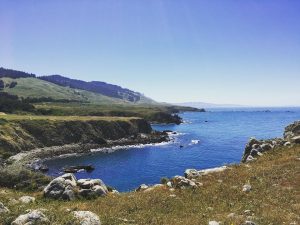
Most of you know that fire season started early this year when Northern California experienced an unusual and very dramatic August lightning storm. The Meyers Fire ignited on August 17th north of Jenner between Highway 1 and Meyers Grade, very close to Fort Ross. Soon thereafter California State Parks teams from Sacramento and Mendocino, assisted by our very own Charon Vilnai (the only staffer who could access the park because she lived north of the fires) arrived to carefully evacuate Fort Ross artifacts in case the fire reached the fort and visitor center. Many tremendously dedicated volunteer fire departments worked around-the-clock to keep the fire from spreading, and while it burned the southern border of Fort Ross park (south of Reef Campground) and threatened to damage water tanks and more, all Fort Ross structures came through unscathed.
I’ve included the narrative from the Timber Cove Volunteer Fire Department so you can appreciate the tremendous efforts required to keep this fire at bay. I have such admiration for the men and women who voluntarily (!!!) take on this incredibly dangerous, selfless, and physically challenging work to keep us safe.
Thankfully the Meyers Fire near Fort Ross was a smaller fire with a relatively happier ending than what other areas experienced. Our hearts go out to our sister park at Armstrong Redwoods and Bullfrog Pond Campground where the fires did more damage.
Historically, September would be the big launch of our high season for outdoor programming, with a near-daily parade of arriving yellow school buses full of boisterous kids. But this year, being 2020, will be different, and the FRC team continues to adapt to ever-changing circumstances. Instead of welcoming school groups, we are working on new ways to bring our outdoor programming to students, teachers, and parents unable to travel in groups. More on that below.
Fort Ross and Salt Point parks are indeed open and ready to receive visitors, as long as you are in mask-wearing groups of less than 12 as per county regulations.
September is truly a good season to visit, and that vast Pacific Ocean washes away most of what ails us.
Be well, be safe,
Sarah Sweedler
Fort Ross Conservancy CEO
A Message From the Timber Cove Fire Protection District Board of Directors
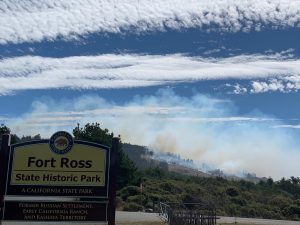
This is a quick account of events after an epic lightning storm hit eleven days ago.
Even before the Meyers Fire kicked in, there were two lightning-related fire calls that needed quick attention. Timber Cove FPD volunteers responded to a fully involved redwood tree on Fort Ross Road above the Fort Ross Orchard, and stayed with it all night in case it flared up. Another fire was extinguished just north of the Tichenor Ranch on Seaview Road.
The most dangerous event, the Meyers Fire, began last Monday with lightning strikes in Fort Ross State Park, on the east side of the highway. Before long, it had spread widely south along Highway 1, both up the hillside and down to the ocean. Timber Cove FPD responded as part of a large, multi-agency team managed by CalFire. Firefighters from our neighboring agencies came to help, including Hilton and Cazadero CalFire, Volunteer Fire Departments from Fort Ross, North Sonoma Coast, Cazadero, Monte Rio, Graton, Occidental, Forestville, Bodega and Bodega Bay, and Fire Departments from Santa Rosa, Petaluma, Cloverdale, Sonoma County Fire, State of Oregon. Enormous help came from CalTrans, county roads, wild dozer operators Mann & Mann, Parmeter & Parmeter, Casey Chambers, Bill Bohan, the Furlongs, and John Bower, plus more help from Bill Seymour, Sonoma County Sheriff’s Department, CHP, and PG&E. And even more!
The mission assigned to our Timber Cove team was to hold the ridge at Meyers Grade Road and keep the fire from growing and spreading to inland communities. At the top of the ridge, the advancing flames were at their most violent and dangerous. Working literally around the clock for several days, our volunteer firefighters under the leadership of Chief Erich Lynn and Assistant Chief Dennis Meredith did just that. A drive along Meyers Grade now will confirm the heroic efforts of our exhausted team. The damage to structures was kept to a remarkable minimum, given the size and intensity of the fire. Now that you can finally drive by, check out the extensive follow up work in progress.
Everyone at Timber Cove FPD is so thankful to our local businesses - Fort Ross Store, Ocean Cove Bar and Grill, Ocean Cove Campground, Ratna Ling, and the Timber Cove Resort - for providing food and beverages. And we send gratitude and thanks to our many, many kind neighbors who baked and prepared treats and nutritious meals. Your provisions and support kept us going.
Fruits of Fall
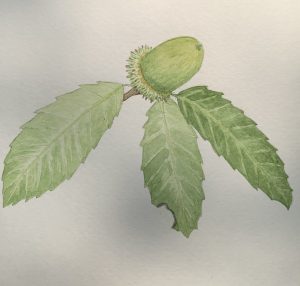
Just beyond the first redwood-covered ridge to the east of Fort Ross you’ll find beautiful rolling hills covered with myriad oak trees. We are a mere four months until the end of the year, and only a month until the start of autumn! Fall is one of the most beautiful times of year to visit Fort Ross State Historic Park. With the relentless winds of spring blown by and the cold foggy days of summer having moved out to sea, fall on the Sonoma coast is clear, bright, warm, and simply stunning! It’s the time to explore these lands and enjoy the fruits of fall.
Not only human visitors to the area are engrossed in outdoors activities. Fall hails the coming of harvest, and in particular, the acorn harvesting season. The beautiful oak woodlands to the east of Fort Ross/Metini have been here providing an excellent food source to not only the native fauna but to the Kashia Band of Pomo Indians, the native California tribe who have lived on these lands for millennia.
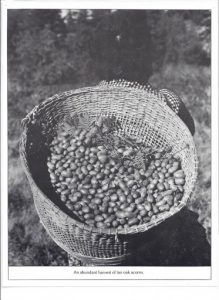
The Kashia collected acorns to process and store for the long rainy winter months. While acorns were also collected from Valley Oak (Quercus lobata) and Coast Live Oak (Quercus agrifolia), the primary species collected was from the Tanoak tree (Notholithocarpus densiflorus). “By all accounts tan-oak, although not a true oak, produced the best tasting acorns.” notes Kent G. Lightfoot and Otis Parrish in California Indians and Their Environment. The tanoak is a relative to the beech and chestnut, which if you’ve ever seen chestnut tree flowers and tanoak tree flowers will come as no surprise. Its distribution is somewhat narrow in a world view, ranging from southwest Oregon to about Santa Barbara, California. Within this range Notholithocarpus has shown itself to be incredibly susceptible to sudden oak death (SOD) with a high mortality rate within this entire range.
Tanoak derives their deceptive name from the fact that early Euro-American newcomers to California used tannins extracted from the inner bark of Notholithocarpus to tan hides into leather. According to Fire Effects Information System (FEIS), this was such a successful venture that, “In the early twentieth century, tanoak was so heavily harvested for its tannin that some managers expressed concern for its eventual elimination.” A surprising note, considering how prevalent they are all over the hills near Fort Ross (many of which are now dead due to SOD).
The Oregon Wood Innovation Center describes their ecological role as, “Considered to be a climax species capable of reproducing in undisturbed forests, it is also well-adapted to disturbance. It sprouts vigorously after fire or cutting and often dominates large areas.” It is no surprise that after the Creighton Ridge fire of 1978 which burned 13,000 acres (the range of hills just to the east /southeast of Fort Ross), much of the lands that burned came back covered in thickets of tanoak.
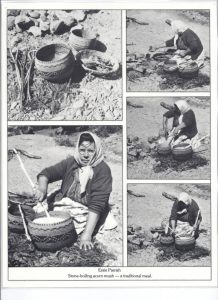
According to Kent G. Lightfoot and Otis Parrish in California Indians and Their Environments, many California Indian tribes historically used fire as a means to keep pests and diseases down, while also managing the landscape, “The oak flats were set on fire after the harvests to reduce underbrush.”
Evidence of this practice has been recorded in and around both Fort Ross and Salt Point State Parks. “Forest ecologist Susan Bicknell has accumulated evidence that many areas of the California coast now covered by forest and scrubland were once coastal prairie. Bicknell and other researchers have concluded that the reduction in these vegetation mosaics result in part from the absence of frequent burning by California Indians” notes M. Kat Anderson in Tending the Wild.
These days the use of prescribed burns as a means of fire prevention is a contentious topic, worthy of its own article. One fact we can take away, learning from the longest caretakers of these lands, is the use of acorns as a superfood. Sandor Katz, author of The Art of Fermentation says it adeptly, “...acorns are largely ignored as a food for human consumption. Meanwhile, ironically, the imminent threat of global food shortages is continually being used to justify deforestation and intensifying biotechnology.”
When collecting acorns in the prime collecting months of September and October you can save your bounty for months when they’ve been properly dried in the sun, all the better for acorn pancakes in December. Always confirm that collecting is allowed in the area you plan to visit, then safely and legally go out and collect some of this historic and native food source.
;Processing acorns takes some time and effort, but in the end is well worth it. As part of our Environmental Living Program, we walk students through each step of acorn processing and preparation. If you have young learners at home and are interested in learning more about acorn processing, we will be offering a Distance Learning Experience to anyone interested in this fun and educational experience. For more information, email Song Hunter.
If acorn harvesting is not for you, simply take a drive up the coast this fall to explore new lands at Fort Ross or Salt Point during the best time of year to visit! Appreciate from afar these trees that have fed and sustained this land’s animals and people for eons.
References -
California Indians and Their Environment by Kent G. Lightfoot and Otis Parrish
Tending the Wild by M. Kat Anderson
The Art of Fermentation by Sandor Katz
Emily Moskal, “Traditional and Modern Methods of Acorn Preparation” Bay Nature
David Bainbridge, “Use of Acorns for Food in California: Past, Present, Future” Timeless Environments
California Native Plant Society - Tanoaks
Oregon Wood Innovation Center - Tanoak
USDA Fire Effects Information System
Images from the Digital Sonoma Library
-- Song Hunter , Director of Programs
Photograph of Russian American Company Buildings Rediscovered
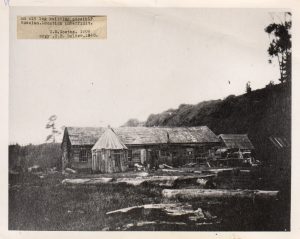
Fort Ross Conservancy appears to have discovered a photograph of buildings erected outside the main fortress compound that look distinctly Russian. The Russian presence spread beyond the immediate vicinity of Fort Ross, and we believe this photo shows one of their other settlements.
In the 1830s and beyond, the Russian-American Company (RAC) built residential and commercial buildings to mark and maintain their presence in Yerba Buena (present-day San Francisco), Farallon Islands, and around Sonoma County through a series of farms (ranchos) in the vicinity of the Slavyanka (Russian) River, and Rumyantsev (Bodega) Bay where the Russians had their main port.
To this day archaeologists have not determined the exact location of these ranchos. Plots once owned by the Russians passed through the Mexican Land Grants before eventually being annexed by American settlers who secured the Sonoma coast in 1846, four years before the state of California was accepted into the Union. Private ownership makes researching historic Russian ranches very difficult.
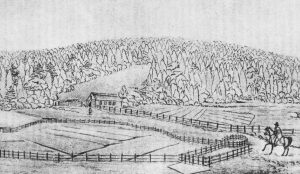 It is believed that the Kostromitinov Rancho was located next to the Willow Creek junction with the Russian River near the town of Jenner. Khlebnikov Rancho operated in the upper valley of Salmon Creek while the New Rancho, also known as Chernykh, spread throughout the valley of Pennington Creek - both east of Port Rumyantsev. Each of these ranchos was a self-sufficient agricultural unit with a house, a banya, a warehouse, and also barracks to shelter the workforce who were presumably well-armed to protect the property. A network of trails connected the ranchos to each other and to Fort Ross and Port Rumyantsev. Unfortunately, only one depiction of these farms, made by Russian explorer and naturalist Ilya Voznesensky in 1841, survived.
It is believed that the Kostromitinov Rancho was located next to the Willow Creek junction with the Russian River near the town of Jenner. Khlebnikov Rancho operated in the upper valley of Salmon Creek while the New Rancho, also known as Chernykh, spread throughout the valley of Pennington Creek - both east of Port Rumyantsev. Each of these ranchos was a self-sufficient agricultural unit with a house, a banya, a warehouse, and also barracks to shelter the workforce who were presumably well-armed to protect the property. A network of trails connected the ranchos to each other and to Fort Ross and Port Rumyantsev. Unfortunately, only one depiction of these farms, made by Russian explorer and naturalist Ilya Voznesensky in 1841, survived.
Can you imagine Fort Ross Conservancy's sheer surprise when we found an old 19th-century photograph that managed to capture a number of structures that looked a bit foreign to the rest of the architecture typically found in Sonoma? “An old log building, possibly Russian,” the picture says in the back, noting that the photograph was taken at an “indefinite” location by C. M. Goethe in 1906.(https://oac.cdlib.org/findaid/ark:/13030/kt100031mt/entire_text/). Charles Matthias Goethe (1875 – 1966) was an American businessman, land developer, and eugenicist who founded the Eugenics Society of Northern California. A native of Sacramento, he also loved the outdoors and spent time exploring his home state with organizations such as the Sierra Club and the Audubon Society in an effort to promote conservation. It was he who apparently took this picture that very few people have seen in the past.
The photograph shows four structures standing at the bottom of a hill. At the epicenter of the picture is a prolonged building with at least three shed structures adjacent to it. The crude construction of the buildings, as well as the overall rough architectural composition, shows a distinctly Russian flavor.
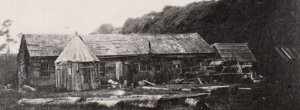
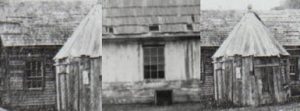
The slanted, round, pointy roof of one of the sheds looks very similar to the tent construction of the bastions and the chapel of Fort Ross. The planking on the roof and the style of windows also point to Russian heritage. The focal point of the picture and the visual proportions of the main building indicate that most likely the structure was built to house RAC employees. Pictures of the barracks from the historical Fort Ross compound prior to 1916 look very similar to this newly discovered building. (In 1916, the barracks at Fort Ross were disassembled to provide original Russian cut timber boards to restore the chapel that was badly damaged in the 1906 earthquake.)
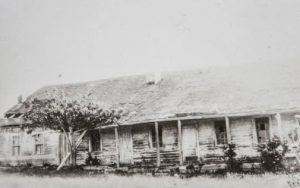
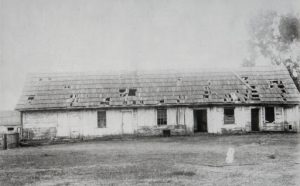
Sutter’s inventory of Russian possessions says that “barracks 10 sazhens (70 feet) long by 3.5 (24.5 feet) wide, divided into three sections, covered in planks” stood at the Khlebnikov’s ranch. A similar but smaller structure measuring “7 sazhens (49 feet) long by 3 (21 feet) wide covered with planks” was built at the Chernykh ranch, while “barracks 8 sazhen (56 feet) long by 3 wide (21 feet), covered with planking with 3 rooms and a vestibule” was built to protect the Kostromitinov ranch.
Preliminary research had led Fort Ross Conservancy to believe that Goethe managed to capture one of the barracks that stood at one of these ranchos. The backdrop of the hill in the background could now help pinpoint the exact location of one of the Russian agricultural/ranching enterprises that have been lost with time. If you are familiar with Sonoma’s topography and landscape and can recognize the hill in the picture, Fort Ross Conservancy would like to hear from you to determine the exact location of the structures that Goethe depicted over a century ago.
-- Igor Polishchuk , Director of External Relations
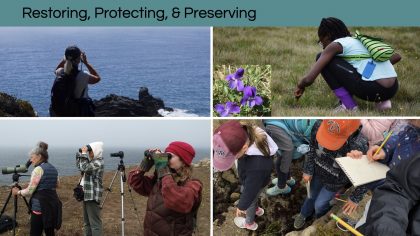
Fort Ross Conservancy now offers distance learning opportunities! We want to support California teachers and parents by bringing the park to you through a one hour distance learning program.
We know the last few months have been incredibly difficult and there are still many unknowns related to the 2020-2021 school year. But there is one thing we do know – outdoor education is essential to the health, happiness, and development of all our youth. With the chaos of Covid-19, now more than ever, our students need to experience nature. We are here to work with you to bring nature to your classroom by providing an interactive trip to Fort Ross your students will never forget.
Your Distance Learning Experience Includes – Learn how the history of Fort Ross is still, to this day, tied to the marine ecology along the Sonoma County coast.
Fort Ross’ history provides a lens through which to examine the ways humans have cared for or exploited the environment around them. Its rich history — starting with the Kashia Pomo, followed by the Russians and early California period — all instruct us to better understand how human impacts have lasting effects on ecosystems.
A Fort Ross Conservancy MEP Instructor takes students on a journey through this California history which is carefully interwoven with local ocean ecology. Together we witness how the intersection of cultural and natural history offer a unique opportunity to learn ocean stewardship:
Experience 1 – Runs for one hour
- Fort Ross, its History and Ecology
- Keystone Species Keep an Ecosystem in Balance
- Citizen Science – You Can Make a Difference!
- Exploring Tide Pools
Experience 2 – Runs for one hour
- Citizen Science & Marine Mammal Monitoring at Fort Ross
- Harbor Seal Surveys
- Sea Lion Surveys
- Exploring the Fur Warehouse
Cost – $5/person/hour – Fort Ross Conservancy is a nonprofit organization that works to connect people to the history and beauty of Fort Ross and Salt Point parks. We are dedicated to providing outdoor youth education for all students. The Fort Ross Distance Learning fees ensure FRC is able to continue providing excellent programming which utilizes Fort Ross’ unique cultural and natural history to teach important ocean stewardship lessons.
Fee Waivers Available! – Public lands and outdoor learning experiences should be widely available. FRC aims to minimize the financial challenges that keep kids from taking important field trips. Thanks to the generous support from our donors we have created the Fort Ross Education Fund to offer program fee waivers and/or transportation subsidies to schools that would otherwise be unable to participate. We welcome teachers of all schools to apply!
Cick here for MEP Distance Learning Application.
For more information contact Director of Programs Song Hunter at songh@fortross.org